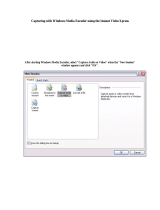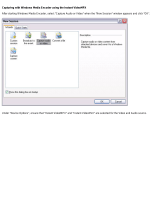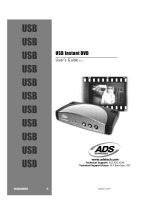Page is loading ...


Copyright and Disclaimer
All rights reserved. No part of this publication may be reproduced, stored in a retrieval system, or
transmitted in any form or by any means electronic, mechanical, photocopying, recording, or
otherwise without the prior written permission of CyberLink Corporation.
To the extent allowed by the laws, POWERDIRECTOR IS PROVIDED "AS IS", WITHOUT
WARRANTY OF ANY KIND, EITHER EXPRESS OR IMPLIED, INCLUDING WITHOUT
LIMITATION ANY WARRANTY FOR INFORMATION, SERVICES, OR PRODUCTS
PROVIDED THROUGH OR IN CONNECTION WITH POWERDIRECTOR AND ANY
IMPLIED WARRANTIES OF MERCHANTABILITY, FITNESS FOR A PARTICULAR
PURPOSE, EXPECTATION OF PRIVACY, OR NON-INFRINGEMENT.
BY USING THIS SOFTWARE, YOU AGREE THAT CYBERLINK WILL NOT BE LIABLE FOR
ANY DIRECT, INDIRECT, OR CONSEQUENTIAL LOSS ARISING FROM THE USE OF THIS
SOFTWARE OR MATERIALS CONTAINED EITHER IN THIS PACKAGE.
The terms and conditions here under shall be governed and construed in accordance with the laws of
Taiwan, Republic of China.
PowerDirector is a registered trademark along with other company and product names mentioned in
this publication, used for identification purposes and remain the exclusive property of their respective
owners.
International Headquarters: CyberLink Corporation, 15F, No.100, Min-Chiuan Road, Hsin-Tian
City, Taipei Hsien, Taiwan, R.O.C.
Web site: support.gocyberlink.com
Telephone #: 886-2-8667-1298
Fax #: 886-2-8667-1467
Copyright © 1999-2001 CyberLink Corporation, Taipei, Taiwan, ROC

i
TABLE OF CONTENTS
Introduction .................................................................... 1
The Digital Video Universe .............................................................. 3
The DV Format: A Brief History ................................................. 3
FireWire .......................................................................................... 4
System Requirements ........................................................................5
Hardware Requirements .............................................................. 5
A Visual Overview ......................................................... 7
1. Library .............................................................................................. 9
2. Storyboard .....................................................................................10
3. Preview Window .......................................................................... 11
4. Modes Wheel ................................................................................13
Capture Mode ...................................................................................14
DV VCR Capture Mode .............................................................. 15
DV Batch Capture Mode ............................................................ 17
Trim Mode .........................................................................................19
Speed Mode ....................................................................................... 21
Titles Mode ........................................................................................22
Effects Mode ...................................................................................... 23
Picture-in-Picture Mode .................................................................. 24
Audio Mode ......................................................................................25
Transitions Mode .............................................................................. 26
The Basics .................................................................... 27
Importing into the Library .............................................................. 27
Previewing your Library Files ........................................................ 29
Detecting Scenes ............................................................................... 31
Storyboard Functions ...................................................................... 34
Menu Selections ................................................................................ 36
File Menu ...................................................................................... 36
9291
9292
9293

ii
Edit Menu ..................................................................................... 37
Modes Menu ................................................................................37
Storyboard Menu ........................................................................ 38
Help Menu ................................................................................... 38
Preferences ........................................................................................ 39
General Preferences ....................................................................39
Display Preferences ..................................................................... 40
Capture Preferences ....................................................................41
Preview Preferences ....................................................................43
Capturing Content ....................................................... 45
Capturing Video and Audio ........................................................... 46
Capturing from DV Camcorders ...................................................50
Capturing from DV Camera Mode ........................................... 50
Capturing from DV VCR Mode ................................................ 53
Batch Capturing from DV Camcorders ........................................ 56
Trimming Video ........................................................... 61
Trim Mode .........................................................................................61
Splitting the Video File ...............................................................63
Trim Mode for Image Files ............................................................. 64
Altering Speed and Supplying Video Effects ............ 67
Altering Speeds ................................................................................ 67
Supplying Video Effects .................................................................. 69
Adding Titles and Transitions .................................... 73
Titles Mode ........................................................................................73
Transitions Mode .............................................................................. 77
Adding Audio and Pictures ........................................ 79
Audio Mode ......................................................................................79
Master Audio ....................................................................................82
Picture-in-Picture Mode .................................................................. 84
Applying Image Color Filters .................................................... 85
Master Watermark ........................................................................... 86
9294
9295
9296
9297
9298

iii
Producing Your Movie ................................................ 87
Producing General MPEG-1 Files ..................................................88
Producing General MPEG-2 Files ..................................................91
Creating Custom MPEG Profiles ................................................... 94
Producing Windows Media Files ................................................... 96
Producing AVI Files ......................................................................... 99
Setting AVI Profiles ................................................................... 102
Producing Movies on a Disc .........................................................104
Technical Support ..................................................... 107
Web Support ...................................................................................107
Fax Support .....................................................................................107
Telephone Support .........................................................................108
Appendix .................................................................... 109
What Is MPEG? ...............................................................................109
NTSC and PAL ............................................................................... 110
Glossary ..................................................................... 111
Index ........................................................................... 117
9299
10

iv

1
CHAPTER 1:
INTRODUCTION
Ever thought about directing your own movie? How about having all the creative
controls and being in charge of the entire editing and post-production process? Well,
today’s computing technology has made all this possible for anyone who has
recording devices, capture devices, a computer, and of course, the sensational new
software application, PowerDirector Standard.
Admittingly, video editing software is not without its drawbacks. Since the advent of
computers and its incredible growth in usage and processing speed power, video
editing software applications have taken off to astronomical heights. Yet, a great
inherent limitation, such as requiring a huge amount of disk space because of the
raw video data it captures, still remains. This is why many still choose to edit with
analog devices.
What makes PowerDirector the megastar of its industry in one quick flash is its
ability to save precious producing time because of its Smart Video Rendering
Technology (SVRT). Say goodbye to raw video data, which is usually captured in
.AVI format, and say hello to plenty of hard drive space with the MPEG and DV AVI
formats. No additional compression nor decompression is required when producing
scenes with MPEG or DV AVI formats that do not contain effects, which saves you
huge amounts of time compared to our competitors that compress and decompress
the entire movie regardless!
And adding SVRT wonderful features that simply enthrall, amaze and stupefy
including:
altering video speeds
detecting scenes
capturing directly from DV camcorders in real-time or non real-time
adding titles to clips
adding audio streams to clips
picture-in-pictures (adding video or images to an existing video clip)

Chapter 1
2
a huge collection of transitions, video and titles effects
master audio files
watermarks
...and there is nothing left to be desired!

Introduction
3
The Digital Video Universe
Profit outlooks and shrinking demand in the technology industry not-withstanding,
the digital video revolution is well underway. There are still home videos to be
edited, videos to be distributed, and full length movies to be produced. In previous
generations, video editing and recording was accomplished through analog means
by video professionals who had access to high-priced machinery and video
equipment. Thus, many of those who wished to edit home footage or videos, if they
were lucky enough to have it recorded in the first place, never had the chance to
display their creative prowess when it came to video editing unless it involved
enrolling in film schools and obtaining access to production studios.
When the computer descended upon our lives and immersed itself in our world, it
was only a matter of time until processing speeds were incredibly fast and disk
space was vast enough to begin editing video at home with software applications
that didn’t require expensive video specialists, equipment or any other gadgets.
And coinciding with the computer industry’s major influence was the birth of the
DV (digital video) format, an international standard intended for consumer use,
back in 1995.
The DV Format: A Brief History
Like a seamless emergence and natural coalescence with desktop video editing, the
advent and proliferation of DV camcorders were sure to spark continued interest in
the infinite possibilities of digital video. What began back in 1995 and a DV format
agreement reached by a consortium of companies that included Hitachi, Ltd., Sony
Corp, Sharp Corporation, Thompson Multimedia, Mitsubishi Electric Corporation,
Victor Corporation of Japan (JVC), Matsushita Electric Industrial Corp. (Panasonic),
Philips Electronics, Sanyo Electric Co. Ltd., and Toshiba Corporation, is still being
ironed out until this day in terms of a consensual format.
The frontrunners at the time and still are until this day, are Sony and Matsushita
(Panasonic), which beat out the competition with their consumer releases hitting the
market first. Soon after though, the format wars began with professional DV
variants such as DVCAM (Sony) and DVCPRO (JVC) despite the DV format
agreement. Luckily, the basic DV format is still intact, but other factors were altered
(i.e. tape type, track pitch and width) so we are still left with backward-compatible
formats or incompatible formats between models from differing companies.
Hopefully, this won’t impact or trickle down to the consumer segment anytime soon.
What exactly is the DV format then? To start with, it has a 5:1 compression ratio and
its compression technology is quite similar to MPEG (e.g. DVD Video format).
Tips: For more information on MPEG, refer to "What Is MPEG?" on page 109.

Chapter 1
4
The difference is that it relies more on intraframe compression where each
compressed frame will depend entirely on itself and not on data from preceding or
following frames like MPEG. However, the DV format does incorporate the use of
adaptive interfield compression where two extremely similar interlaced fields of a
frame will be compressed together to save space.
The analog generation is slowly witnessing its demise. There is still room left for
analog technology, but as the DV format perfects its compression technology and
enhances their non-linear editing (NLE) friendliness, the analog generation will soon
be outdated, fainting memories from a bygone era. Add to this the continued
popularity of video editing software and the uncompromising blazing speed of
computer processing power, and the perfect union between DV recording and
editing couldn’t be any more natural or fitting.
FireWire
In the early courting stages of video editing software and DV format recording, there
had to be an intermediary between the two technologies to make it a success,
because as you know from analog transference, there is always data lost from the
original source. FireWire, or IEEE-1394, is this unerring technology when it comes to
data loss, as in “lossless” transfer. A serial data transfer protocol and interconnection
(bi-directional) system, FireWire transmits digital video (DV) offering a higher
transfer rate and incorporating the use of hot-plugging technology (i.e. connecting
and disconnecting without shutting down the host computer).

Introduction
5
System Requirements
Windows 98SE, ME, 2000, XP
Hardware Requirements
Pentium II 450 or above
Note: For hardware requirements when capturing from your DV camcorder or analog
devices, please refer to the most up-to-date Readme.
200MB of free hard drive disk (HDD) space
Video capture devices (optional)
capture cards (PCI, USB, FireWire or other FireWire formats)
DV camcorder or DV VCR
analog camcorders or VCRs in 8mm, Hi8, VHS, VHS-C or Beta formats
digital camera
PC camera
Playback
Internet Streaming: Pentium II 266 with MMX Technology, Microsoft
Windows Media Player 7.0, IE 5.0
Desktop Slide Show: Pentium II 266 with MMX Technology

Chapter 1
6

7
CHAPTER 2:
A VISUAL OVERVIEW
Note: Images of the Modes Wheel contained in this chapter will be based on the
PowerDirector Pro version.
Button/Icon Description
A i-Power Activates i-Power on the Web for resources
B Minimize Minimizes PowerDirector
1 3 A B C42
D

A Visual Overview
9
1. Library
Button/Icon Description
A Show All Media Shows all media files in Library
B Show Video Shows all video files in Library
C Show Audio Shows all audio files in Library
D Show Images Shows all image files in Library
E Detect Scenes Detects scenes for a selected file in the Library
F Import Media Imports media files
G Import Directory Imports all media files in a directory
H Large Icons Displays Library media files as large icons
I Details Displays Library media files with file details
ACDB EHIF GA

Chapter 2
10
2. Storyboard
Button/Icon Description
A Play Movie Plays your movie (preview before producing)
B Master Watermark Activates Master Watermark mode
C Master Audio Activates Master Audio mode
D Scroll Left Scrolls Storyboard left
E Scroll Right Scrolls Storyboard right
A
B
C
D
E

A Visual Overview
11
3. Preview Window
Button/Icon Description
A Pause Pauses file
B Stop Stops playing file
C Play Plays file
D Start To start of file
E Apply Applies clip to Storyboard (if applicable)
F End To end of file
G Previous Frame Moves to previous frame
H Next Frame Moves to next frame
ADBFCGHIE

Chapter 2
12
I Record Records file (if applicable depending on mode)
Button/Icon Description

A Visual Overview
13
4. Modes Wheel
Button/Icon Description
A Preview Mode Switches to the default Preview Mode
B Trim Mode Switches to Trim Mode
C Speed Mode Switches to Speed Mode
D Titles Mode Switches to Titles Mode
E Effects Mode Switches to Effects Mode
F PiP Mode Switches to Picture-in-Picture (PiP) Mode
G Audio Mode Switches to Audio Mode
H Transitions
Mode
Switches to Transitions Mode
I Capture Mode Switches to Capture Mode
J Produce Movie Switches to Produce Movie
I
A
C
B
D
E
F
G
H
J

Chapter 2
14
Capture Mode
Button/Icon Description
A Audio Capture Captures audio source only
B Video Capture Captures video and audio source (if applicable)
CDV Capture Captures DV source
D Setup Setups for audio/video sources and profiles
A B DC
/



